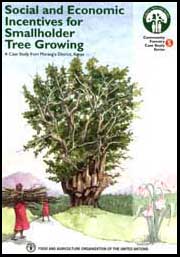 Social and economic incentives for smallholder tree growing
Social and economic incentives for smallholder tree growing Social and economic incentives for smallholder tree growing
Social and economic incentives for smallholder tree growing
A Case Study from Murang'a District, Kenya
Community Forestry Case Study Series
by Peter A. Dewees
FOOD AND AGRICULTURE ORGANIZATION OF THE UNITED NATIONS
| The designations employed and the presentation of material in this publication do not imply the expression of any opinion whatsoever on the part of the Food and Agriculture Organization of the United Nations concerning the legal status of any country, territory, city or area or of its authorities, or concerning the delimitation of its frontiers or boundaries. |
All rights reserved. No part of this publication may be reproduced, stored in a retrieval system, or transmitted in any form or by any means, electronic, mechanical, photocopying or otherwise, without the prior permission of the copyright owner. Applications for such permission, with a statement of the purpose and extent of the reproduction, should be addressed to the Director, Publications Division, Food and Agriculture Organization of the United Nations, Via delle Terme di Caracalla, 00100 Rome, Italy.
Layout by MAXTUDIO • Rome - Cover illustration Studio Dickerson
Chapter 2: The changing rural capital and labour markets
2.1 Labour use in smallholder agriculture
2.2 Capital transactions in smallholder agriculture
2.3 Smallholder responses to constrained labour and capital supplies
2.4 Conclusion: Tree growing and factor markets
End notes
Chapter 3: The evolution of Kikuyu land tenure
3.1 Trees and land tenure
3.2 The sub-clan holding (gėthaka) as the basic land unit
3.3 Changing tenure and land use systems
3.4 Changes in land tenure and their impact on tree tenure
3.5 Summary: Changes in land tenure and the impacts of consolidation
Chapter 4: Tree cultivation and management practices
4.1 Tree tenure
4.2 Trees as boundary markers
4.3 Protected forests and woodlands
4.4 Other tree management practices
4.5 Summary: Trees as part of traditional land use practices
Chapter 5: The case of black wattle
5.1 The introduction of black wattle
5.2 The political economy of early wattle production
5.3 Soil conservation and wattle in the 1940s
5.4 Consolidation and the post-independence wattle economy
5.5 Current wattle planting practices
End notes
Chapter 6: Conclusion: Tree growing and the rural economy in Kenya